Approachable and proudly Norwegian, the Royal Family of Norway blends centuries of tradition with a refreshingly modern image. It has its issues, but it earns global admiration as one of Europe’s most down-to-earth monarchies.
While many monarchies around the world remain steeped in tradition, Norway’s Royal Family stands out for its progressive views, compassionate public image, and surprisingly down-to-earth lifestyle.
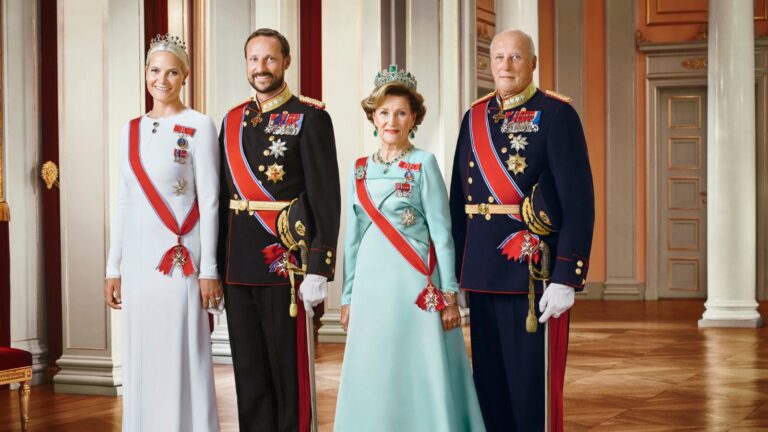
Whether riding public transport or delivering heartfelt speeches, King Harald V and his family have struck a rare balance between royal duty and personal authenticity.
In this guide, we’ll explore who’s who in the royal family, the difference between the Royal House and Royal Family, and where the royals reside when not performing official duties.
Table of Contents
Royal Family vs. Royal House
In Norway, the monarchy is defined not just by tradition but by a clear legal and ceremonial structure that separates two closely related but distinct groups: the Royal House and the Royal Family.
The Royal House (Kongehuset) refers to the core members of the monarchy who perform official duties on behalf of the state. This includes the reigning monarch and their spouse, the heir apparent and their spouse, and the heir apparent's eldest child.
These individuals typically appear in state ceremonies, represent Norway abroad, and are formally supported by the state in their roles. Read more on the official Royal House website.
By contrast, the Royal Family (Kongelige familie) encompasses a broader group. It includes all of the monarch's children and their spouses, grandchildren, and siblings.
While they may take part in family occasions, charitable work, and certain ceremonial appearances, they do not necessarily carry out official state functions on a regular basis.
Read more: One Big Royal Family – The British and Scandinavian Royals
This distinction helps define the responsibilities and public roles within the monarchy, ensuring that while the entire family is recognised and respected, only a small group are engaged in daily public duties.
It also reflects the Norwegian monarchy's modern approach to balancing tradition with transparency and efficiency.
HM The King
Born on 21 February 1937, King Harald V has served as the monarch of Norway since 17 January 1991, following the death of his father, King Olav V.
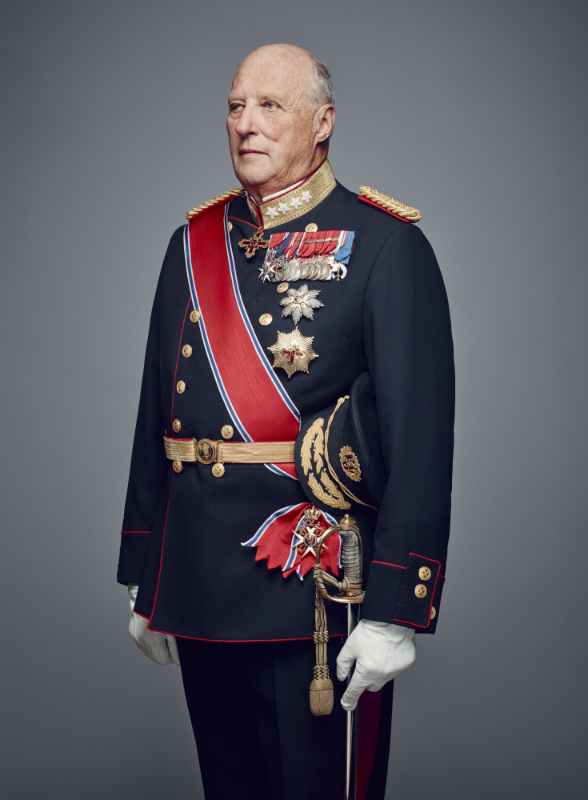
He was the third child and only son of King Olav and Crown Princess Märtha of Sweden, which placed him as the heir to the throne from an early age.
As a child, Harald experienced the turmoil of World War II firsthand. During the Nazi occupation of Norway, the royal family fled the country, and Harald spent much of his early years in exile in the United States.
These formative experiences instilled in him a deep appreciation for democracy and national unity, values that have guided his reign.
King Harald has played a pivotal role in modernising the Norwegian monarchy. Under his leadership, the royal family has embraced transparency, public engagement, and progressive values.
His decision to marry a “commoner”, Sonja Haraldsen, despite significant opposition, marked a turning point for the monarchy and set an example of inclusivity that resonates to this day.
Beyond his royal duties, Harald is known for his passion for sport. He represented Norway in sailing at three Olympic Games—Tokyo 1964, Mexico City 1968, and Munich 1972.
His sporting achievements extended beyond the Olympics, with medals at the sailing World Championships, including a gold in 1987. This lifelong enthusiasm for outdoor life and physical fitness reflects the values of many Norwegians and strengthens his public image as a relatable, down-to-earth monarch.
Although now in his late eighties and increasingly delegating duties to his son, Crown Prince Haakon, King Harald remains an enduring symbol of unity and stability. He continues to deliver impactful public speeches that speak to the heart of Norwegian identity. One of his most quoted addresses celebrated the diversity of the nation:
“Norwegians are girls who love girls, boys who love boys, and boys and girls who love each other. Norwegians believe in God, Allah, everything and nothing.”
This speech, delivered in 2016, was widely praised around the world for its openness, compassion, and progressive tone—hallmarks of King Harald's reign.
HM Queen Sonja
Queen Sonja, born on 4 July 1937 in Oslo, has carved out a distinctive and much-respected role within the Norwegian monarchy.
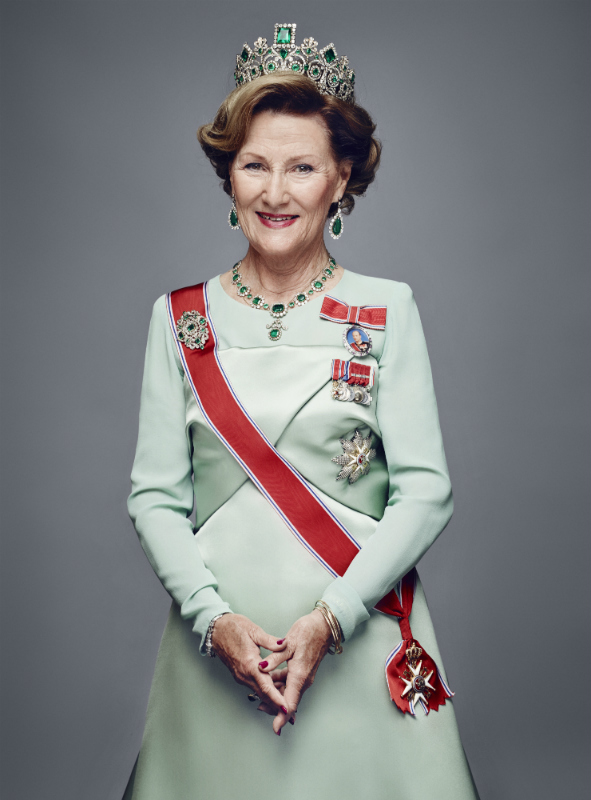
The daughter of Karl August Haraldsen, a clothing merchant, and Dagny Haraldsen, she grew up in a middle-class household and went on to study fashion design and social economics in Switzerland and at the University of Oslo.
She met Crown Prince Harald in 1959, and their relationship, though deep and enduring, remained hidden from the public eye for nearly a decade.
As a commoner, she was initially considered an unsuitable match for the future king, and it took years before King Olav V granted his permission for them to marry.
Their eventual wedding, held in Oslo Cathedral on 29 August 1968, was a significant moment for the monarchy and marked a shift towards greater inclusivity and modernisation.
Throughout her time as Queen, Sonja has been deeply engaged in public life and has earned admiration for her work on social and humanitarian issues.
She served as Vice President of the Norwegian Red Cross and was instrumental in establishing the Princess Märtha Louise's Fund, which supports children with disabilities. She has also promoted Norwegian culture and heritage through her patronage of the arts, particularly in literature and music.
In addition to her formal duties, Queen Sonja is an accomplished artist and photographer, with several exhibitions of her work held both in Norway and abroad.
She has co-authored books and is known for her keen interest in environmental issues and outdoor activities, often hiking and skiing in the Norwegian countryside.
Queen Sonja remains a steadfast partner to King Harald and a respected figure in her own right. Her blend of grace, compassion, and quiet strength has helped shape the public image of the modern Norwegian monarchy.
Even in her later years, she continues to be active in royal life, representing the country with dignity at home and abroad.
HRH Crown Prince Haakon
Born on 20 July 1973, Crown Prince Haakon is the heir apparent and only son of King Harald and Queen Sonja.
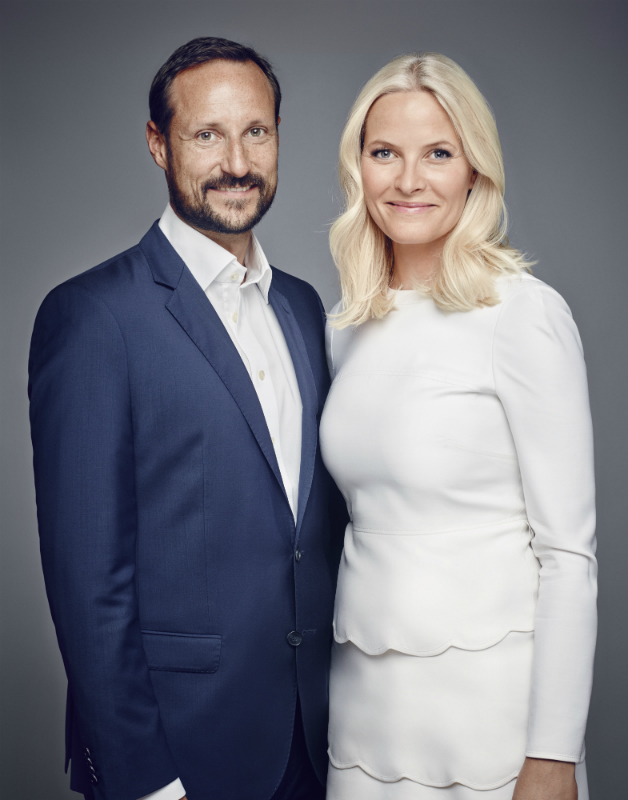
Educated in Norway, the U.S. (UC Berkeley), and the UK (London School of Economics), he holds degrees in political science and development studies.
Haakon has served in the Royal Norwegian Navy and represents Norway in both national and international forums. He is passionate about sustainability, youth empowerment, and innovation.
He is married to HRH Crown Princess Mette-Marit, who came from a non-royal background and was a single mother when they met. Their marriage in 2001 marked a turning point for the royal family’s image, reinforcing its reputation for inclusion.
Together, they have two children. Their daughter, Princess Ingrid Alexandra, was born in 2004 and is currently second in line to the Norwegian throne.
She has already taken on some public duties and is seen as a future modern monarch, having made speeches and participated in official events since her teenage years.
Their son, Prince Sverre Magnus, was born in 2005. Although not expected to take on a senior royal role in the future, he occasionally appears at public events and celebrations alongside his family.
Mette-Marit also has an older son, Marius Borg Høiby, from a previous relationship, though he is not part of the royal house. In recent years, he has been at the centre of some public controversies, including reports of legal troubles and questionable associations that have drawn media scrutiny.
These incidents have reignited public debate around the privacy of royal relatives who are not actively involved in official duties.
HRH Princess Ingrid Alexandra
Princess Ingrid Alexandra, born on 21 January 2004, is the eldest child of Crown Prince Haakon and Crown Princess Mette-Marit.
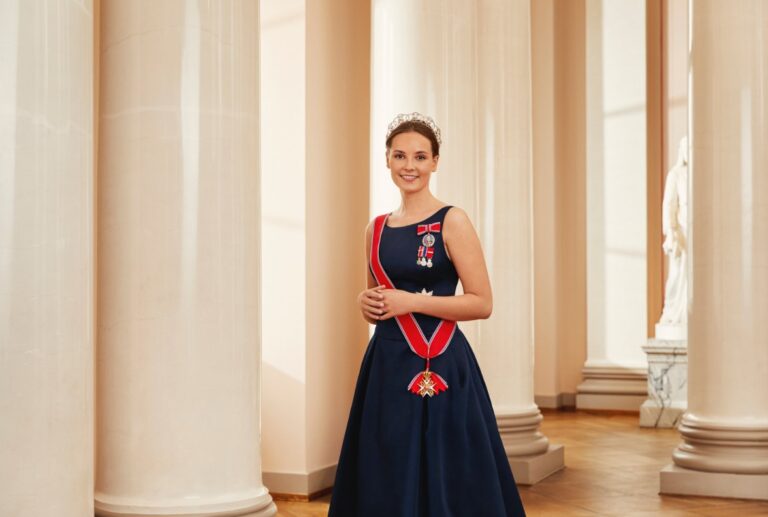
As second in line to the Norwegian throne after her father, she is set to become Norway’s first female monarch in over six centuries, marking a historic moment in the country’s royal lineage.
From an early age, Ingrid Alexandra has appeared alongside her family at important public events, including Norway’s National Day and various royal anniversaries.
In recent years, she has begun to step into a more prominent public role, reflecting the royal family’s long-term preparations for her future responsibilities.
In 2022, she celebrated her 18th birthday with an official gala and delivered her first public speech, signalling the beginning of her adult royal duties.
She is currently completing her education and preparing for future roles through both academic and military training.
Like many young Norwegians, she balances a relatively normal upbringing with the expectations that come with royal life, participating in outdoor activities and sports while remaining in the public eye.
Her calm demeanour, modern outlook, and growing confidence have made her a popular figure among the Norwegian public, particularly with the younger generation.
As a future queen, Princess Ingrid Alexandra represents a modern monarchy that values continuity, service, and openness. Her emergence into public life is being carefully managed, but it is clear she will play a central role in shaping the future image and duties of the Norwegian Royal Family.
HH Princess Märtha Louise
Princess Märtha Louise is the only daughter of King Harald and Queen Sonja. Born in 1971, she has long pursued an independent path, engaging in literature, alternative therapy, and spiritual ventures.
She was married to author and artist Ari Behn, with whom she had three daughters: Maud Angelica, Leah Isadora, and Emma Tallulah. The couple divorced in 2017. Ari Behn sadly passed away in 2019.
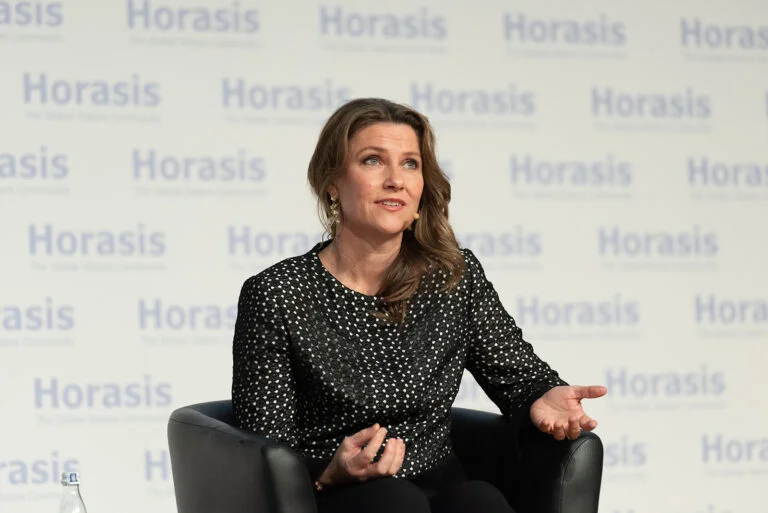
Märtha Louise is now married to American spiritual guide Durek Verrett, a relationship that has drawn both media attention and public debate in Norway.
HH Princess Astrid
Princess Astrid, born in 1932, is King Harald’s older sister. During World War II, she and her family fled to the United States. After the war, she studied in England before returning to Norway.
She married commoner Johan Martin Ferner and had five children. Though largely retired from public life, Princess Astrid has long played a supportive role in the royal family.
Her sister, Princess Ragnhild, was King Harald’s eldest sibling. She passed away in 2012.
Royal Residences in Norway
The Norwegian Royal Family splits its time between several official and private residences across the country.
The Royal Palace (Det kongelige slott)
Situated prominently at the top of Karl Johans gate, Oslo’s main thoroughfare, the Royal Palace is one of Norway’s most recognised landmarks and a symbol of the modern monarchy.
Commissioned in the early 19th century during the reign of King Karl III John, construction began in 1825 and was completed in 1849. The palace was designed by Danish-born architect Hans Linstow and reflects a neoclassical architectural style that was popular across Europe at the time.
Today, it functions as the official residence of the King and Queen of Norway and serves as a venue for state affairs and formal receptions.
The palace is surrounded by a large park, Slottsparken, which is open to the public year-round and offers scenic walking paths, gardens, and statues.
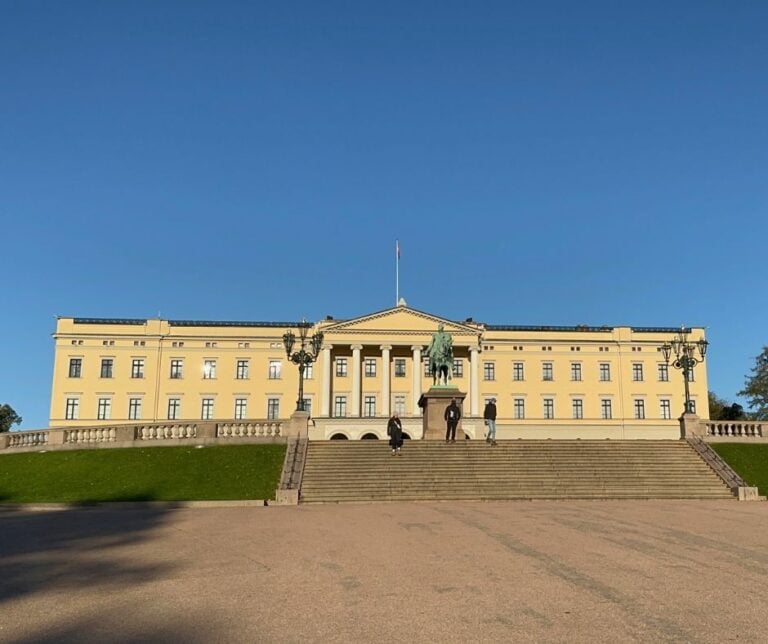
Each summer, parts of the palace open to visitors through guided tours, offering a rare glimpse into the ceremonial heart of Norway’s constitutional monarchy.
Oscarshall
Located on the Bygdøy Peninsula in Oslo, Oscarshall is a picturesque summer palace built between 1847 and 1852 at the behest of King Oscar I and Queen Joséphine.
Designed by architect Johan Henrik Nebelong, the palace showcases a striking example of Neo-Gothic style and is considered one of the architectural jewels of 19th-century Norway.
It was originally intended as a royal retreat and continues to serve that function today, although it is not used for official duties.
Read more: A Timeline of Norwegian History
Oscarshall also holds a special place in the cultural history of Norway. The interiors feature works by prominent Norwegian artists of the time, and the building itself was intended as a statement of national identity during a period of union with Sweden.
The palace is open to the public for guided tours during the summer months and frequently hosts exhibitions and cultural events.
Ledaal
Ledaal is the King’s official residence in Stavanger and serves as a royal residence during visits to western Norway. The historic property dates back to the turn of the 19th century, having been built between 1799 and 1803 by wealthy merchant and shipowner Gabriel Schanche Kielland.
The manor was initially used as a private summer residence by the Kielland family and stands today as an example of classic Norwegian architecture from the late 18th and early 19th centuries.
Ledaal was acquired by the city of Stavanger in the 20th century and was restored and furnished for royal use after World War II. It is now jointly maintained as a museum and a royal residence, highlighting its dual role in preserving regional history and hosting the monarchy.
While not frequently used for public tours, the property is a cherished local landmark and remains closely tied to the city’s civic and ceremonial life.
Other Properties
In addition to their primary residences, the Norwegian Royal Family also makes use of several other properties throughout the country, each serving different seasonal and ceremonial purposes.
Bygdø Royal Farm, located in Oslo, functions as both a working farm and a peaceful countryside retreat for the royals. It is one of the more frequently used informal residences.
Kongsseteren, often referred to as The King’s Villa, is situated near Holmenkollen and is used as a winter residence, particularly during the Christmas season. It offers a cosy setting in the hills above Oslo, away from the city centre.
In the west of Norway, Gamlehaugen in Bergen serves as the King’s official residence when visiting the region. This stately mansion, surrounded by parkland and overlooking a fjord, is one of the most picturesque royal homes.
Sikkilsdalen Chalet in the Gudbrandsdal valley is a beloved retreat for Easter and summer holidays. Tucked away in the mountains, it reflects the royal family’s deep connection with Norwegian nature and outdoor life.
Finally, the Royal Yacht Norge is a distinctive part of the family’s lifestyle. Used for official visits and private summer cruises, the yacht symbolises both tradition and modernity in royal travel
From Olympic sailor to spiritual author, from palace to public bus, Norway’s royals reflect the diversity and modernity of the nation they serve. Planning a visit? A stroll up Karl Johans gate to the Royal Palace offers a fitting glimpse into one of the world’s most admired modern monarchies.


Didn’t you forget someone? What about Princess Ragnhild?
Maybe they were only including living royals
Both my father and my maternal grandfather were named “Harald” in honor of Norwegian Kings. In both cases, American clerks apparently decided that their names should honor the English King Harold instead and so their names were recorded officially with the English spelling. I see that your article splits the difference and spells the current kíng’s name both ways!
My middle name is Harald, as given to me by my parents. My mother especially preferred the Norwegian spelling and pronunciation, but I chose to use the English pronunciation and spelling. Similarly with my first name Arne, although I use the Norwegian spelling.
I am a descendant of the family. I have the N231 haplotype, a true Viking. In Norwegian my name is Kjaer.
What about Stiftsgården in Trondheim?